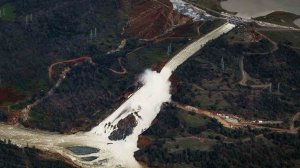The crisis over the last few weeks at Oroville Dam was about how to handle large amounts of water flowing into the lake with both of the reservoir’s spillways damaged.

But there also was a seismic angle to the story. As Lake Oroville swung from being at 41% of capacity to 101% in just two months, scientists are asking whether the filling of the reservoir at the fastest rate in at least a generation can produce a damaging earthquake.
No one knows for certain, but the question has been a source of debate since shortly after America’s tallest dam was built, and a magnitude 5.7 earthquake occurred that some believe was related to an unprecedented lowering and rise of reservoir levels. Moreover, two microearthquakes were detected last month soon after Lake Oroville began rushing over its emergency spillway.
About a day and a half after officials ordered mass evacuations of more than 100,000 people downstream of Oroville Dam — fearing the collapse of a hillside eroded by the overflowing lake — two tiny temblors were recorded. They struck in the early hours of Valentine’s Day, just before 3 a.m.: a magnitude 0.8, and then a 1.0.
Click here to read the full story on LATimes.com.















